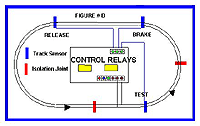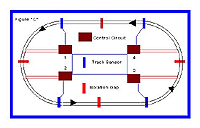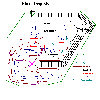Power, Sound, R/C
:
Remote Control
An Introduction to DCC - Part 6
Feb 7, 2002


By Fred Hughes |
Author
Bio
Automating your layout is not an all or nothing proposition.
|
Baby Steps to Automation
Automating your layout is not an all or nothing proposition. It may be that we only wish to maintain spacing between two trains on an oval. This can be accomplished with one simple control. In Figure "B" if two trains are traveling around an oval the trailing train will be stopped at the "TEST" sensor until the lead train reaches the "RELEASE" sensor.

Click for larger picture
This arrangement will not guarantee a collision free operation but is simple to install and unless the trains are running at drastically different speeds the separation will be maintained. This control can be assembled with 2 LGB EPL switches or by assembling 2 DPDT relays available from electronic supply companies.
If we wish to insure collision free operation then it is necessary to prohibit trains from entering any "Control Block" that is currently occupied by another train. If this is required it is necessary that the ROUTE TO BE AUTOMATED be divided into "Control Blocks". Each "Control Block" will prevent a train entering that block from moving to the next forward "Control Block" until it is vacant.
In Figure "C" we can see an oval that is divided into 4 "Control Blocks". This configuration will allow for as many as 3 trains to be on the layout and still have one "Control Block" vacant.

Click for larger picture
With 3 trains on this layout, the VACANT BLOCK is continually occupied by the train from the prior block. This will assure that no 2 trains are ever in the same "Control Block"
This arrangement will be BORING as only 1 train can move at any given moment and so automating a layout should be done in a manner that allows for several EMPTY "Control Blocks" at any one time. To promote more action in this arrangement the maximum number of trains should be limited to two.
We do not have to automate our entire Garden Layout and there are certainly many times when we want total control over the layout.
The introduction of DCC allows us to have complete flexibility. From TWO WIRE layouts for multiple trains to fully automated operations and anything between!
The book "Digital Command Control" published with cooperation of the NMRA will give anyone the basics necessary to assemble their own controls. A circuit to maintain spacing on a main line is relatively simple and is described on page 92 of the publication. Other situations require more logic.
Building the Hiwan Loop RR

Click for larger picture

Click for larger picture

Click for larger picture

Click for larger picture

Click for larger picture

Click for larger picture
|  | For my Hiwan Loop RR I wanted the best of both worlds. The ability to allow the grandkids to control their own train was important. However my layout has a large section of track that is hidden underground and out of view. This hidden section has a helix that allows trains to enter a tunnel high on the mountain and emerge sometime later at a much lower level. With 100 feet of track hidden from view a "collision control" system was mandatory.
I did not wish to experience the expense or the frustration of trying to install a "Personal Computer" and learning how to program the software and so the only alternative remaining was the braking method outlined in "The comprehensive guide to DCC".
My first "Control Blocks" were fashioned with LGB components but as I added more features to the Garden the cost of LGB EPL switches and motors encouraged me to find a better solution. $100 per Block became expensive and in addition to simple control of multiple trains on a single line I desired to have other traffic controls. |
I looked for dispatching controls where I could have a train enter a station and stop at a passenger platform where it would be held until another train on a parallel line entered the station. Then have the trains released one by one to a main line. Automatic crossover protection, staging ladders, bi-directional traffic were some of the conditions that interested me. None of these DCC accessories were commercially available so the only choice was to build my own.
Once I developed the automatic controls for my garden, guests requested information on where they could be purchased. Because the controls were custom built I could only offer the wiring schematics for the main line "Block Control" and "Station Control" using LGB products to those interested in assembling their own. These diagrams are available at no charge.
Top of Page
|



